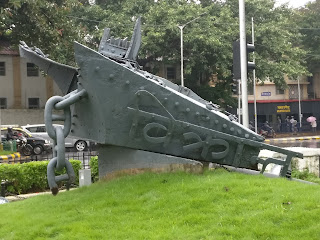With Love from Mumbai
I
bring you images from my random walk in the heritage precinct of Mumbai on a
rain-swept day.
Traffic
island sculptures have always fascinated me. This sculpture opposite Lion Gate
of the Naval Dockyard is of the iconic warship INS Vikrant. It is special
because it is made out of the metal scraps collected from the venerable ship
itself; from the shipbreaking yard where she was put to death. The sculpture not
only reminds us of the country’s first aircraft carrier, but is also a
testimony of our shame of not treasuring and preserving our legacy.
Kala
Ghoda, which is synonymous with a week-long art festival every February, got a
new equestrian statue at the beginning of this year. But it is not the same,
for it has no rider! The original statue, after which Kala Ghoda acquired its
name, has long been shifted to the zoo; because some people were ashamed of the
rider (King Edward VII) on the black horse.
This
building constructed in Venetian Gothic style in 1870 houses one of the oldest
and finest library and reading room. It is named after the most famous and
munificent Jew of Bombay, David Sassoon. In 2006, it was named among the 47
classic libraries of the world. Annual membership costs ₹1200.
This
is the country’s oldest surviving Cast Iron building, Esplanade Mansion. The
cast iron frame of the building was made in England and then shipped to India.
Built in 1871, it was known as Watson’s Hotel. Mark Twain stayed at this hotel
in 1896. Jamsetji Tata was refused entry into the hotel, and a piqued Tata
promptly built the Taj Mahal hotel, few hundred meters away. And it was here
cinema was born in India, when on July 7th 1896, the Lumière brothers sent Marius
Sestier to screen their six short films.
This
part of the city is replete with heritage buildings and among them rises this
building of Central Bank of India with its distinctive dome. Established in
1911, this was one of the first commercial banks to be wholly owned and managed
by Indians; the first chairman was none other than Sir Pherozeshah Mehta.
Ismail
Building has been very recently renovated. Built in 1906, in neoclassical
style, it was earlier owned by the family of Sir Mohamed Yusuf, a philanthropist
proprietor of Bombay Steam Navigation Company.
The
Metro will finally come to this part of the city, mercifully underground and
not disturbing the heritage skyline. But it is a shame that the heritage
precinct doesn’t have a cycling track, like what we have in Europe.
Some
Parsee families in the city still procure water from holy wells like the Bhikha
Behram Well. The water used to be delivered by hand-pulled carts. Now we have
tankers like these.
Navsari
Building (named after the native town of Jamsetji Tata) is one of the most
striking buildings on the heritage mile because of its red façade. But it has a
secret hidden inside – the oldest functioning lift of the country. It is
manually cranked.
And
finally, the pièce de
résistance of the walk. This is a not so often photographed side of
the CST building, a UNESCO World Heritage Site.



















You missed Elphinstone College! Lovely photos, thanks!
ReplyDelete